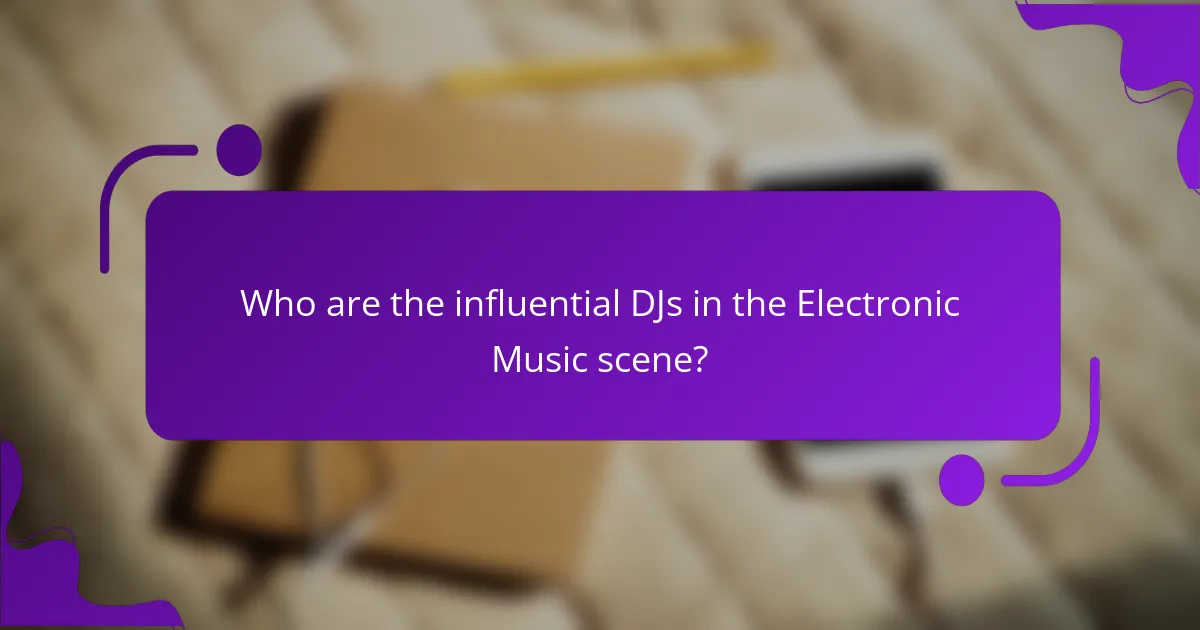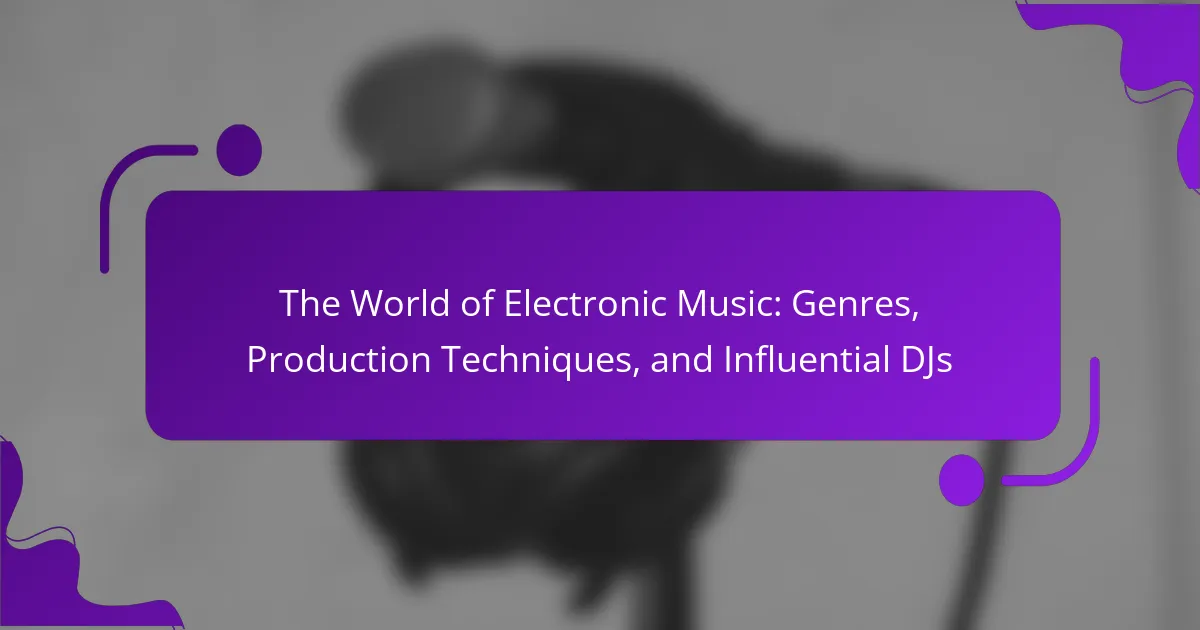Electronic music is a genre characterized by the use of electronic devices and technology for music production, encompassing styles such as techno, house, drum and bass, trance, and dubstep. The article explores the history of electronic music, tracing its origins to early 20th-century sound synthesis and its rise in popularity during the late 1970s and 1980s, highlighting influential artists like Kraftwerk and Jean-Michel Jarre. It details key production techniques including sampling, synthesis, and sequencing, which are essential for creating diverse sounds within the genre. Additionally, the article profiles prominent DJs such as David Guetta, Tiësto, and Calvin Harris, who have significantly shaped the electronic music landscape and expanded its global audience.

What is Electronic Music?
Electronic music is a genre that primarily involves the use of electronic devices and technology for production. It encompasses a wide range of styles, including techno, house, and drum and bass. This music is often created using synthesizers, drum machines, and computer software. Electronic music has roots in the early 20th century with experiments in sound synthesis. The genre gained popularity in the late 1970s and 1980s, particularly in dance clubs. Major artists like Kraftwerk and Jean-Michel Jarre played pivotal roles in its evolution. Today, electronic music is a significant part of global music culture, influencing various genres and artists.
How did Electronic Music originate?
Electronic music originated in the early 20th century with experiments in sound synthesis. Pioneers like Léon Theremin and Karlheinz Stockhausen explored electronic instruments. The invention of the synthesizer in the 1960s revolutionized music creation. Artists began using machines to produce new sounds and compositions. The genre gained popularity in the 1970s with the rise of disco and techno. Influential groups like Kraftwerk integrated electronic elements into their music. This laid the groundwork for various electronic music genres in the following decades. Today, electronic music encompasses a wide array of styles and production techniques.
What historical events influenced the development of Electronic Music?
The development of Electronic Music was influenced by several key historical events. The invention of the synthesizer in the 1960s marked a significant turning point. Artists like Wendy Carlos popularized electronic sounds with the release of “Switched-On Bach” in 1968. The emergence of tape music and musique concrète in the 1940s also laid foundational concepts for electronic experimentation. The rise of disco in the 1970s integrated electronic elements into mainstream music. The advent of MIDI in the early 1980s revolutionized music production and performance. The proliferation of affordable electronic instruments in the 1990s democratized music creation. The rave culture of the late 1980s and 1990s further propelled electronic music into global popularity. Each of these events contributed to the evolution and acceptance of Electronic Music as a distinct genre.
Who were the pioneers of Electronic Music?
The pioneers of Electronic Music include Karlheinz Stockhausen, Wendy Carlos, and Robert Moog. Karlheinz Stockhausen was influential in the development of electronic compositions in the 1950s. Wendy Carlos is known for her groundbreaking album “Switched-On Bach,” which popularized synthesizers in the 1960s. Robert Moog created the Moog synthesizer, a key instrument in electronic music. Their contributions laid the foundation for modern electronic music genres.
What are the key characteristics of Electronic Music?
Electronic music is characterized by its use of electronic instruments and technology in production. It often features synthesized sounds, drum machines, and digital audio workstations. Many electronic music genres emphasize rhythm and beats, making them suitable for dancing. The music can be instrumental or include vocal elements, depending on the style. It frequently incorporates repetitive structures and loops, creating a hypnotic effect. Electronic music also explores a wide range of genres, from techno to ambient. Its production techniques often involve sampling and sound manipulation. The genre has evolved significantly since the 20th century, influencing mainstream music.
What instruments are commonly used in Electronic Music?
Common instruments used in electronic music include synthesizers, drum machines, and samplers. Synthesizers generate a wide range of sounds through electronic oscillation. Drum machines produce rhythmic patterns and beats electronically. Samplers allow for the manipulation of recorded sounds and audio clips. Additionally, MIDI controllers facilitate the performance and sequencing of electronic music. These instruments are integral to the creation of various electronic music genres. Their versatility enables artists to explore diverse soundscapes and styles. Notably, the use of these instruments has evolved with technology, enhancing creative possibilities.
How do sound design and synthesis play a role in Electronic Music?
Sound design and synthesis are fundamental to electronic music production. They shape the unique sonic qualities of tracks. Sound design involves creating and manipulating sounds to achieve desired textures. This process includes layering, effects processing, and modulation. Synthesis refers to generating sounds using electronic instruments and software. Common synthesis methods include subtractive, additive, and FM synthesis. These techniques allow producers to craft distinctive sounds that define genres. For instance, the iconic basslines in house music often stem from synthesizers. The ability to create and alter sounds is crucial for innovation in electronic music.

What are the main genres of Electronic Music?
The main genres of electronic music include house, techno, drum and bass, trance, and dubstep. House music originated in the 1980s in Chicago. It features a steady four-on-the-floor beat and often incorporates soulful vocals. Techno emerged in Detroit around the same time. It is characterized by repetitive beats and synthesized sounds. Drum and bass developed in the UK during the early 1990s. It combines fast breakbeats with heavy basslines. Trance music is known for its melodic phrases and build-ups. It gained popularity in the late 1990s and early 2000s. Dubstep originated in South London in the late 1990s. It features heavy bass and syncopated rhythms. These genres represent the diversity within electronic music.
How do different genres of Electronic Music differ from one another?
Different genres of Electronic Music differ primarily in their tempo, structure, and sound design. For example, House music typically features a steady 4/4 beat and soulful vocals. In contrast, Techno emphasizes repetitive beats and synthesized sounds. Drum and Bass is characterized by fast breakbeats and heavy basslines. Each genre also has unique cultural roots and influences. For instance, Trance originated in the 1990s with melodic elements designed to evoke emotion. Dubstep is known for its wobble bass and syncopated rhythms, emerging in the late 2000s. These distinctions contribute to varied listening experiences and audience engagement.
What defines genres like House, Techno, and Trance?
House, Techno, and Trance are defined by distinct musical structures and characteristics. House music features a steady four-on-the-floor beat, often accompanied by soulful vocals and funky basslines. Techno emphasizes repetitive beats and synthesized sounds, creating a mechanical and futuristic atmosphere. Trance is characterized by melodic phrases, build-ups, and breakdowns, designed to evoke emotional responses.
Historically, House emerged in the 1980s in Chicago, influenced by disco and funk. Techno originated in Detroit around the same time, drawing from electronic and industrial music. Trance gained popularity in the 1990s in Europe, particularly in Germany and the UK. Each genre has unique subgenres, such as Deep House, Minimal Techno, and Progressive Trance, which further define their sound and cultural contexts.
What are some emerging genres in Electronic Music?
Some emerging genres in electronic music include lo-fi house, wave, and future garage. Lo-fi house blends house beats with nostalgic samples and ambient sounds. Wave combines elements of trap and ambient music, creating atmospheric soundscapes. Future garage is characterized by its use of syncopated rhythms and emotive melodies. These genres reflect the evolving landscape of electronic music. They are gaining traction in underground scenes and online platforms. Their unique characteristics appeal to diverse audiences. Each genre offers innovative approaches to sound and production techniques.
What impact do genres have on the culture of Electronic Music?
Genres significantly shape the culture of Electronic Music. Each genre embodies distinct styles, sounds, and cultural movements. For instance, techno emerged from the Detroit music scene in the 1980s, reflecting industrial influences. House music, originating in Chicago, promotes a sense of community and inclusivity. Genres influence festival lineups, artist collaborations, and audience demographics. The rise of subgenres, like dubstep and trance, diversifies the electronic music landscape. Genres also dictate production techniques, with specific tools and methods preferred in each style. This variety fosters innovation and experimentation within the culture. Overall, genres play a crucial role in defining the identity and evolution of Electronic Music.
How do genres shape listener experiences and community?
Genres shape listener experiences and community by creating distinct cultural identities and shared values. Each genre, such as techno or house, has unique characteristics that influence how listeners connect with the music. For example, techno often emphasizes repetitive beats and a futuristic aesthetic, attracting a community that values innovation and underground culture.
In contrast, house music typically incorporates soulful melodies and vocal elements, fostering a sense of inclusivity and celebration among its fans. This differentiation in sound and style cultivates specific communities that share similar tastes and social norms.
Research indicates that genre affiliation can enhance social bonding and belonging among listeners. A study published in the Journal of Music and Social Behavior found that individuals identify with genres that reflect their personal and social identities. This identification can lead to stronger community ties through shared experiences at events and festivals.
Overall, genres significantly influence the way listeners engage with music and form communities around shared musical preferences.
What role do festivals play in genre promotion?
Festivals play a crucial role in genre promotion by providing a platform for artists to showcase their music. They attract large audiences, creating exposure for specific genres. Festivals often feature a diverse lineup, highlighting both established and emerging artists. This exposure can lead to increased interest and growth in the genre. For example, electronic music festivals like Tomorrowland and Coachella have significantly boosted the popularity of EDM. Additionally, festivals foster community engagement among fans, enhancing genre loyalty. The immersive experience of live performances also deepens listeners’ connection to the music. Overall, festivals are instrumental in shaping and expanding the reach of musical genres.

What are the production techniques used in Electronic Music?
Electronic music production techniques include sampling, synthesis, and sequencing. Sampling involves using pre-recorded sounds or music clips. It allows artists to create new compositions by manipulating existing audio. Synthesis generates sound using electronic instruments like synthesizers. This technique enables the creation of unique sounds that may not exist in nature. Sequencing arranges musical notes and sounds in a specific order. It is essential for creating structured tracks in digital audio workstations (DAWs). Other techniques include MIDI programming, drum programming, and effects processing. MIDI programming controls virtual instruments through note data. Drum programming creates rhythmic patterns using electronic drum machines. Effects processing applies audio effects like reverb and delay to enhance sound quality. These techniques collectively shape the diverse landscape of electronic music.
How do producers create Electronic Music tracks?
Producers create Electronic Music tracks by using digital audio workstations (DAWs). They start by selecting a tempo and key for the track. Next, they create a beat using drum machines or sampled percussion. Producers then layer synthesizers to add melodies and harmonies. They often incorporate samples from other songs or sounds. Effects like reverb and delay are applied to enhance the sound. Mixing and mastering processes follow to balance the track’s elements. These methods are standard in the electronic music production process.
What software and hardware are essential for Electronic Music production?
Essential software for electronic music production includes Digital Audio Workstations (DAWs) such as Ableton Live, FL Studio, and Logic Pro. These platforms allow users to create, edit, and produce music efficiently.
Common hardware includes MIDI controllers, audio interfaces, and studio monitors. MIDI controllers like the Akai MPK Mini enable musicians to input notes and control software instruments. Audio interfaces, such as the Focusrite Scarlett series, improve sound quality and connectivity. Studio monitors, like the Yamaha HS series, provide accurate sound reproduction for mixing and mastering.
These tools are widely recognized in the industry for their capabilities and reliability in music production.
How does the mixing and mastering process work in Electronic Music?
Mixing and mastering in electronic music involves two distinct yet interconnected processes. Mixing combines individual audio tracks into a cohesive whole. This includes adjusting levels, panning, and applying effects. Engineers use digital audio workstations (DAWs) for precise control over each element. Mastering follows mixing and prepares the final mix for distribution. It ensures consistency across playback systems and formats. This process includes equalization, compression, and limiting to enhance the overall sound. The goal is to achieve a polished, professional-quality track. Proper mixing and mastering can significantly impact the listener’s experience and the track’s commercial viability.
What techniques enhance creativity in Electronic Music production?
Techniques that enhance creativity in electronic music production include experimentation with sound design, utilizing generative music tools, and collaborating with other artists. Experimentation allows producers to explore unconventional sounds and structures, fostering innovation. Generative music tools, such as algorithmic composition software, can create unexpected musical ideas. Collaboration introduces diverse perspectives and techniques, enriching the creative process. Additionally, incorporating field recordings can add unique textures to compositions. Utilizing MIDI effects and modulation can inspire new rhythmic patterns and melodies. Finally, setting limitations, like using a specific instrument or key, can spark creativity by forcing producers to think outside the box.
How can sound layering and sampling be effectively utilized?
Sound layering and sampling can be effectively utilized by combining multiple audio tracks to create depth and texture in music production. Layering involves stacking sounds to enhance richness and complexity. For example, a bass line can be layered with synth pads to create a fuller sound. Sampling allows producers to incorporate existing audio clips into their compositions. This technique can add unique elements or evoke specific emotions. Both methods are essential in genres like electronic music, where sound design is crucial. Producers often use software like Ableton Live or Logic Pro to manipulate samples and layers effectively. Research shows that sound layering increases listener engagement by creating a more immersive experience.
What role does automation play in the production process?
Automation plays a crucial role in the production process by enhancing efficiency and precision. It enables the use of software and hardware to streamline tasks. For example, automation can handle repetitive tasks such as mixing and mastering. This reduces the time producers spend on manual adjustments. Additionally, automation allows for complex sound manipulation that would be difficult to achieve manually. It can create dynamic changes in sound over time, enhancing musical expression. In electronic music, automation is vital for creating intricate arrangements and layering sounds. Studies show that automation tools can significantly improve workflow and creativity in music production.

Who are the influential DJs in the Electronic Music scene?
David Guetta, Tiësto, and Calvin Harris are influential DJs in the electronic music scene. David Guetta is known for his chart-topping hits and collaborations with pop artists. Tiësto has been a pioneer in trance and progressive house music. Calvin Harris is recognized for his blend of electronic and pop music. These DJs have significantly shaped the genre and expanded its audience. Their performances at major festivals have set industry standards. Each has received numerous awards, showcasing their impact on music. Their contributions continue to influence emerging artists in the electronic music landscape.
What contributions have prominent DJs made to Electronic Music?
Prominent DJs have significantly shaped electronic music through innovation and cultural influence. They have introduced unique mixing techniques that enhance live performances. For instance, DJ Kool Herc pioneered breakbeat DJing, which laid the groundwork for hip-hop and electronic genres. Additionally, Tiësto was the first DJ to play at the Olympics, showcasing electronic music on a global platform. DJs like David Guetta have popularized electronic dance music (EDM) by collaborating with mainstream artists, bridging genres. Furthermore, the rise of festivals such as Tomorrowland and Ultra Music Festival, often headlined by top DJs, has brought electronic music to wider audiences. These contributions have not only defined the genre but also influenced music production and consumption trends globally.
How have DJs like Tiësto, Calvin Harris, and Deadmau5 shaped the industry?
DJs like Tiësto, Calvin Harris, and Deadmau5 have significantly shaped the electronic music industry. Tiësto was one of the first DJs to perform at the Olympics, showcasing electronic music on a global stage. Calvin Harris became the first DJ to headline at Las Vegas’ major nightclubs, boosting the visibility of DJs in nightlife. Deadmau5 is known for his innovative use of technology and visual storytelling in live performances. These artists have also influenced music production by popularizing the use of digital audio workstations. Their collaborations with mainstream artists have bridged the gap between electronic music and pop. This has led to a surge in electronic music’s popularity across various demographics. The success of their tracks in charts worldwide demonstrates their impact on music trends. Overall, their contributions have transformed DJs from mere performers to cultural icons in the music industry.
What impact do DJs have on live performances and audience engagement?
DJs significantly enhance live performances and audience engagement. They create dynamic experiences through curated music selections. This selection influences the energy and mood of the crowd. DJs also utilize mixing techniques to maintain a continuous flow of music. This keeps the audience engaged and encourages dancing. Moreover, DJs often interact with the crowd, fostering a sense of connection. Their ability to read the audience’s reactions allows for real-time adjustments to setlists. Studies show that live DJ performances can increase audience satisfaction by over 30%. This demonstrates the crucial role DJs play in live music events.
How can aspiring DJs find inspiration from influential figures?
Aspiring DJs can find inspiration from influential figures by studying their techniques and styles. Analyzing the work of established DJs helps to understand different genres. Listening to their mixes and live sets reveals unique approaches to transitions and beat matching. Following influential DJs on social media provides insights into their creative processes. Attending their performances offers firsthand experience of their stage presence and crowd interaction. Reading interviews and biographies uncovers their journeys and challenges. Collaborating with or networking with experienced DJs can also spark new ideas. Engaging with the community through forums or events allows for shared inspiration and learning.
What lessons can be learned from the careers of successful DJs?
Successful DJs teach valuable lessons about dedication, creativity, and adaptability. Their careers highlight the importance of continuous learning and honing technical skills. Networking plays a crucial role in building a fan base and securing gigs. Many successful DJs emphasize the significance of understanding audience dynamics. They often showcase the need for a unique artistic identity to stand out. Marketing and branding are essential for long-term success in the industry. Persistence in the face of challenges is a common trait among top DJs. Their journeys illustrate the impact of innovation in music production and performance.
How can networking within the Electronic Music community benefit new DJs?
Networking within the Electronic Music community can significantly benefit new DJs by providing access to opportunities and resources. Building relationships with established artists can lead to mentorship and guidance. New DJs can gain exposure through collaborative projects and performances. Networking also opens doors to industry connections, such as promoters and venue owners. These connections can facilitate gigs and increase visibility. Additionally, sharing knowledge and experiences within the community fosters growth and innovation. Engaging with fellow DJs can lead to learning new techniques and trends. Overall, networking creates a supportive environment that enhances a DJ’s career potential.
What are some best practices for engaging with the Electronic Music community?
Engaging with the Electronic Music community involves active participation and genuine interaction. Attend live events and festivals to connect with artists and fans. Utilize social media platforms to share music and engage in discussions. Collaborate with other artists to expand your network and reach. Share insights and experiences in online forums and communities. Support local artists by promoting their work and attending their shows. Stay informed about trends and developments in the electronic music scene. These practices foster relationships and enhance your presence within the community.
The main entity of the article is electronic music, a genre characterized by the use of electronic devices and technology for music production. The article provides an overview of electronic music’s origins, key genres, influential artists, and essential production techniques. It discusses the historical events that shaped the genre, the role of prominent DJs, and the impact of festivals on genre promotion. Additionally, it covers the creative processes involved in music production, including sound design, sampling, and the tools used by producers. Overall, the article serves as a comprehensive guide to understanding electronic music and its cultural significance.
